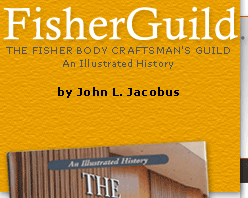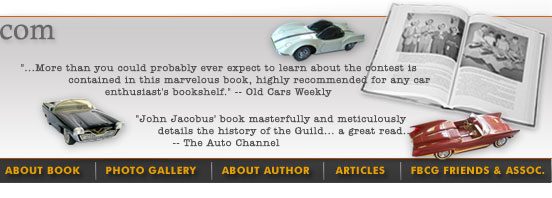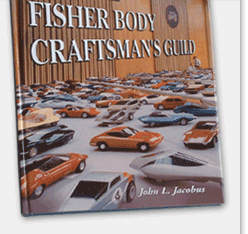|
T R A N S C R
I P T O F R
E V I E W
Fisher Body Craftsman's Guild Reunion
- 2004
(This Story First Appeared in COLLECTIBLE
AUTOMOBILE 12-04)
By Steve Purdy
Imagine you’re a teenage boy in the
1950s standing in the hall of a magnificent
city hotel wearing the blazer and beret
given to you by General Motors Corporation
in honor of your selection as a finalist
in this prestigious car-modeling contest.
You’ve never been away from home except
for summer camp. Now you’re waiting
to file into the huge ballroom with dozens
of other boys from around the country who
have also won their regional competitions.
You hear an orchestra playing inside. You’re
breathing deeply. Cradled in your clammy
hands is the model car you spent hundreds
and hundreds of hours designing and crafting
to perfection. If you are chosen one of
the national winners, the future as a car
designer you’ve lusted for is virtually
assured.
Inside the ballroom hundreds of guests are
seated as the GM executives and other dignitaries
wearing white dinner jackets file into their
seats on the long dais. In the center of
that auspicious group is larger-than-life
GM design chief Harley Earl, the only one
in a black dinner jacket. He always liked
to stand out in a crowd. Among the dignitaries
are legendary “Boss” Kettering,
the presidents of MIT and Cal Tech and keynote
speaker, Lowell Thomas.
You and the other boys file into the ballroom
to a second tier of seats just below the
dais, set your cars down on the white tablecloth
in front of you and take another deep breath.
It will be a wonder if you’re able
to eat the fantastic meal in front of you.
There will be eight winners, four juniors
(11 to 15-years-old) and four seniors (16
to 19-years-old) with cash and scholarships
in the balance.
After a few short speeches and some preliminary
activities the moderator begins announcing
the winners. Forth place in the Junior Division;
third place; second . . . forth place in
the Senior Division; third place; second.
As each winner is announced you feel relief
that you are still in contention for top
prize but at the same time you fear that
you’re not going to win any of the
awards. Kettering’s message, presented
completely off-the-cuff, that just being
in the room means you are a winner and have
the talent and skill that will carry you
far, is not resonating with you now.
The rest of the week is a blur with lunch
at the Bloomfield Hills Country Club, a
trip to Harson’s Island, tours of the
GM design studios. Five days as the honored
guest of General Motors is something that
strikes you with awe, and changes your life.
THE REUNION
Fast-forward about 50 years to June of 2004.
You’ve come back to Detroit for the
first ever reunion of the Fisher Body Craftman’s
Guild. You’ve brought your lovingly
preserved model wrapped in a soft cotton
cloth and secured in a wooden box. You carefully
remove the swaddled model, unwrap it, hold
it in both hands like a newborn baby, and
place it with dozens of others on the stage
to be admired by all.
The Design Dome at the General Motors Tech
Center in Warren, Michigan is the site of
the first ever reunion for Guildsmen of
all ages. You come to reminisce, reacquaint
and be entertained again by patron GM. Nearly
one hundred Guildsmen attend, many with
family in tow, to see old friends and meet
others who share the common bond of having
been part of the Guild competition, a unique
closed society. The oldest is Henry Larzelere
a 1936 coach winner; the youngest, Tom Graboski,
won the Styling Award at age 13 in 1968,
the final year.
The reunion happened because John Jacobus
(1st Place State 1956), historian and author
from Washington DC, was working on a book
about the Fisher Body Craftsman’s Guild
competition. Assisting with research for
the book his friend John Mellberg (2nd Place
National Senior winner 1966), an automotive
designer at Thomas Built Buses of North
Carolina, along with retired GM design boss,
Chuck Jordan (1st Place Senior Award 1947),
had compiled a rather extensive database
of Guildsmen. While Mellberg and Jordan
were commiserating about how great it would
be to get the group together Jordan said
“Let’s do it in conjunction with
the Eyes On Design show.” Planning
began.
General Motors staff, with a little prodding
from Jordan, hosted the reunion including
a tour of a design studio where aspiring
young design interns from six countries
showed off projects being developed. The
technology and the diversity is certainly
beyond what could have been imagined in
the Guildsmen’s days, but it was clear
that the creativity still comes from within
the minds of the youngsters, not from computer
programs.
On the patio of the Design Dome were displayed
Buick’s very first and most recent
concept cars side-by-side – Y-Job and
Velite respectively. The former a late 30’s
idea of futuristic auto design, the latter,
just introduced at the New York Auto Show,
a lovely 4-seat convertible destined for
production. The Guildsmen gathered around
these two for a group photo.
John Manoogian II, director of design, Premium/Mid-Lux/Prestige/Performance
Vehicles for GM gave the keynote address.
Manoogian talked about the direction of
GM design, particularly Cadillac’s
bold initiative. As the banquet wound down
emotions were high as an impromptu impassioned
speech was made by a Guildsman from the
50s who was overwhelmed by the need to thank
GM and his fellows.
The Guildsmen reassembled on Sunday morning
under a tent at the Eyes On Design show
on the luxurious front lawn of the Edsel
and Eleanor Ford estate overlooking Lake
St.Clair. Dr. Philip Hessberg, director
of the Detroit Institute of Ophthalmology,
host and beneficiary of the show said, “Eyes
On Design is all about design so it is very
appropriate to bring the Guild cars here.”
Bill Scott, well-known retired GM designer
and Guildsman from 57’, ’58, and
’59 has been a key member of the EOD
committee during its entire history and
facilitated the display.
The reunion lasted through Monday as the
group was hosted again by GM, this time
at the brand new GM Heritage Center a few
miles north of the Tech Center. The GM car
collections, including extensive archives,
have been brought under one large roof in
a non-descript industrial park building.
Not a museum in the modern sense like the
Henry Ford with cultural and contextual
displays, rather it is a well-lit storage
and viewing facility for about 200 special
cars and trucks and racks of archives.
THE HISTORY
The Fisher Body Craftsman’s Guild began
in 1930, as a way for the company to identify
and recruit young men with exceptional skill
in the “crafts” needed to design
and build bodies for automobiles. In the
beginning the challenge was to build a replica
of the Napoleonic coach that was the symbol
of Fisher Body. The boys would be provided
plans and specifications but many of the
details were left to interpretation. It
was more than just an assembly process.
A great deal of creativity in design and
materials was required for a competitive
entry. It was not unusual for a youngster
to spend well over a thousand hours on a
model. The winners received cash and scholarships
that often triggered successful careers
at Fisher Body and GM.
By 1937, in order to broaden the base of
entries and entrants, the competition included
model automobiles in addition to classic
coaches. By 1947 coaches were out and cars
were in. Until the early 50s the competition
specified that models would be based on
a 4-door sedan, then convertibles and sports
cars were allowed. Finally by the late 50s
an “open class” emerged. Chuck
Jordan describes the competition as a scholarship
program, not for athletics or academics,
but purely for creativity.
Boys were recruited nation-wide in a variety
of ways. Magazine advertisements, flyers,
brochures and other conventional means were
augmented by teams of recruiters who hit
the road visiting as many as 1200 high schools
in one season. Teams of young men, single
and fresh out of college, spread out around
the country bringing a practical science
program to middle and high schools. It was
a boon to GM in terms of Guild recruitment
as well as promoting GM to youngsters just
beginning to drive. Complimented by the
thrilling Motorama tours, GM became the
most visible and most exciting carmaker
to young people.
In 1968 the Fisher Body Craftsman’s
Guild was cut by GM. Declining numbers and
quality of entries, as well as an inability
of executives outside of the design departments
to see the net value of the program, made
the Guild vulnerable to the axe.
The demise of the Craftsman’s Guild
was a bitter disappointment for everyone
involved. Jordan, the guild’s strongest
advocate within the corporation, believes
it was purely an economic move. “The
GM design staff cherished the Guild,”
he lamented, “It allowed them to reach
out to young people, getting them to think
about GM as a career. The Guild and GM were
brothers.” He goes on, “We were
all sad when Jim Roach announced its cancellation.
It was cost cutting time.”
THE GUILDSMEN
Larry, Glenn and Raymond Hagen, three brothers
originally from Brighton, Minnesota, all
competed in the Guild. Larry’s art
teacher in high school saw his talent at
sculpting and first encouraged him to enter.
It then became a family tradition with the
ardent support of their engineer father
and artist mother. All three attribute the
Guild competition with influencing their
career choices and opening opportunities
that would not have happened otherwise.
Chuck Pelly, 1954 Junior award winner, was
a car nut as a kid and made his Guild entry
in a rubber mold. The shape of the mold
primarily influenced the shape of the car.
He painted it “mandarin red” winning
a scholarship that took him to the Art Center
College of Design in California then to
Europe, broadening his horizons immeasurably.
Pelly was awarded the Lifetime Achievement
award at the Eyes On Design show.
Tom Goad of Birmingham, Michigan took 1st
place in the Junior Division in 1948. His
dad was a GM manager and presided at some
of the banquets. Dad wanted Tom to go into
auto design but young Tom wanted to be an
engineer. Tom got his way and spent a long
and varied career at GM doing everything
from race cars to concept cars. Retired
now Goad is a noted collector of classic
cars and editor of the Classic Car Club
of America magazine.
Ron Pellman earned four trips to Detroit.
He had never been out of western New York
prior to his first trip. “Seeing the
new GM Tech Center was a life-altering experience,”
he said. “Like entering a new world.”
He was numb with excitement at the banquet
but he does recall “Boss” Kettering
getting a standing ovation from the crowd
after the MC had asked everyone to hold
applause until all introductions were made.
Pellman went on to an automotive design
career including his own company designing
race cars.
Galen Wickersham is originally from Oklahoma
but his entry was sent from the Washington
DC region. His dad was a Congressman. On
the train trip to Detroit in both ’48
and ’49 he met up with other boys with
the same destination. Tom Goad’s dad
was MC and Harley Earl was the most memorable
personage there.
Each of the Guildsmen has a story worth
telling. Beloved patriarch of the group,
Chuck Jordan, for example, has gone back
to working with youngsters by teaching auto
design to high school students. The Guildsmen
universally agree that the competition was
crucial in their young lives. Learning to
stick with a project, exercise their creative
muscles, compete with the best, meet industry
titans, and earn the rewards of their hard
work set them on an accelerated course toward
a successful adulthood.
[John Jacobus’ book on the Fisher Body
Craftsman’s Guild published Fall 2004.
Use the McFarland Publishing web site (http://www.theautochannel.com/link.html?http://www.mcfarlandpub.com/)
to place an order, or contact them by phone
at 800-253-2187 or by FAX 336-246-4403.
An order can be placed by mail at: McFarland
and Company, Inc., Publisher, P.O. Box 611,
Jefferson, North Carolina 28640.]
|





